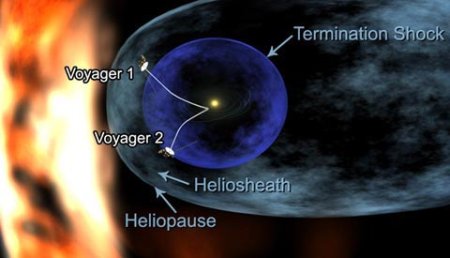I don’t want today to pass without noting that it is the thirtieth anniversary of the launch of Voyager 2. Both Voyagers remain healthy, continuing studies of the solar wind, magnetic fields and energetic particles with their five functioning science instruments. As this JPL news release notes, the Voyagers run on less than 300 watts of power, which they tap from radioisotope thermoelectric generators. At 15.5 billion kilometers (Voyager 1) and 12.5 billion (Voyager 2), the vehicles are the farthest human-made objects, unable to use the power of distant Sol.

Image: Artist concept of the two Voyager spacecraft as they approach interstellar space. Image credit: NASA/JPL.
So our first mission into nearby interstellar space continues to go quite well, with both spacecraft reporting home despite one-way radio travel times of fourteen and twelve hours respectively. Voyager 1 seems to have encountered the heliosheath — where the solar wind slows as it encounters the thin gas between the stars — in late 2004. Voyager 2’s likely encounter with the heliosheath, which may begin later this year, should provide further information about this distant area. Larry Klaes published a nice overview of Voyager’s famous golden records today.


Voyager reports for weeks 08-03-2007 and 08-10-2007 Available
http://voyager.jpl.nasa.gov/mission/weekly-reports/index.htm
September 5, 2007 marks the 30th Anniversary of Voyager 1 (~ 103.7 AU or 9.6 billion miles)
Three new links for Voyager 2 have been added to the main page:
http://voyager.jpl.nasa.gov
Latest Cosmic Rays data
http://voyager.gsfc.nasa.gov/heliopause/v2la1.html
Latest Low Energy Charged Particles data
http://sd-www.jhuapl.edu/VOYAGER/images/vgr_qlp/v2_lecp/v2_1h_06_07_8ion.pdf
Latest Plasma Science data
http://web.mit.edu/afs/athena/org/s/space/www/voyager/voyager_data/overview_plot.gif
Regards
Enrique
Op-Ed Contributor
The Mix Tape of the Gods
By TIMOTHY FERRIS
Published: September 5, 2007
San Francisco
Podcast: Timothy Ferris Discusses the Voyager (mp3)
THIRTY years ago today, the Voyager 1 space probe — a one-ton robotic craft whose long antennas make it look rather like a spider the size of a school bus — was launched from Cape Canaveral, Fla., on a mission to reconnoiter Jupiter and Saturn. To succeed, Voyager would have to survive five years in the vacuum of space, where it would encounter cosmic rays, solar flares, the hurtling rocks and sand of the asteroid belt, and Jupiter’s intense radiation bands.
The probe did all that, transmitting back reams of scientific data and memorable color photos: of the sputtering red and yellow volcanoes of Jupiter’s moon Io; of the shimmering blue ice that shrouds Io’s fellow satellite Europa, beneath which a liquid ocean is suspected to dwell; of Saturn’s myriad rings and the murky mysteries of its orange satellite, Titan, whose hazy atmosphere is thought to approximate that of the early Earth.
Having accomplished its mission, Voyager 1 might have quietly retired. Instead it remains active to this day, faithfully calling home from nearly 10 billion miles away — so great a distance that its radio signals, traveling at the speed of light, take more than 14 hours to reach Earth. From Voyager’s perch, the Sun is just another star, south of Rigel in the constellation Orion, and the Sun’s planets have faded to invisibility.
Like its twin, Voyager 2 — which dallied behind to examine the outer planets Uranus and Neptune and is departing the solar system on another trajectory — Voyager 1 is approaching the edge of the solar system. That limit is defined by a teardrop-shaped bubble called the heliosphere, where the solar wind (particles blown off the Sun’s outer atmosphere) comes to a halt.
If all continues to go well, Voyager should pierce the heliosphere’s outer skin by around 2015. It will then depart into the void of interstellar space, where it is destined to wander among the stars forever.
Mindful of this mind-boggling fact, the astronomers Carl Sagan and Frank Drake persuaded NASA to attach a gold-plated phonograph record to each of the Voyager spacecraft.
Containing photographs, natural sounds of Earth and 90 minutes of music from all over our world, the record was intended to preserve something of human culture beyond what an intelligent extraterrestrial, encountering the craft at some far-distant time and place, might infer from the spacecraft itself.
The information etched into the grooves of the Voyager record is expected to last at least one billion years. That’s a long time: A billion years ago, life on Earth was first venturing forth from the seas.
Full article here:
http://www.nytimes.com/2007/09/05/opinion/05ferris.html?_r=2&oref=slogin&oref=slogin
Voyager 2 to Cross Solar Wind “Termination Shock” Boundary
Using a computer model simulation, Haruichi Washimi, a
physicist at University of California, Riverside, has predicted
when the interplanetary spacecraft Voyager 2 will cross the
“termination shock” the spherical shell around the solar system
that marks where the solar wind slows down to subsonic speed
at 7-8.5 billion miles from the sun in late 2007-early 2008.
Full article here:
http://www.dailygalaxy.com/my_weblog/2007/11/voyaer-11-to-cr.html